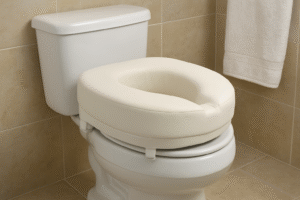Recovering from surgery often means adjusting even the most basic daily routines. One of the most overlooked challenges is using the bathroom. After procedures such as hip or knee replacements, a raised comfort toilet seat can make a world of difference. Unlike standard plastic models, these seats prioritize padding, support, and ergonomic design, easing recovery while making daily life safer and more comfortable.
In this article, I’ll explain what a raised comfort toilet seat is, why it’s especially valuable after surgery, how to choose the right one, and the best ways to use it safely and effectively.
Why a Raised Comfort Toilet Seat Helps After Surgery
After surgery, bending or sitting can feel awkward, painful, or even risky. Standard toilet heights often force you to move in ways that put stress on healing joints, hips, or the lower back. That extra strain may cause fatigue, discomfort, or even increase the risk of a fall if balance isn’t steady yet.
A raised comfort toilet seat solves this by adding extra height while providing padded cushioning for sensitive areas. This combination reduces the effort required to sit and stand, relieves pressure on healing joints, and provides a more comfortable sitting experience overall. Many occupational therapists and rehab specialists recommend them as part of a recovery plan, since they support independence while easing physical strain.
What Makes Raised Comfort Toilet Seats Different?

Unlike basic plastic risers, raised comfort toilet seats are designed with longer-term use and comfort in mind. Here are some common features:
-
Padded Surfaces – Soft cushioning helps relieve pressure, especially if you need to sit for longer periods.
-
Armrest Options – Built-in or attachable armrests provide extra stability for standing up or lowering yourself safely.
-
Bolted or Secure Fit – Comfort seats often fasten more securely than basic plastic models, preventing slipping or wobbling.
-
Adjustable Heights – Many designs let you fine-tune the height to suit your body and recovery needs.
-
Easy-to-Clean Covers – Most comfort seats use wipeable or removable padded covers, making hygiene simple during recovery.
By combining support with softness, these seats are especially helpful if recovery takes weeks—or if you need an ongoing mobility aid.
Choosing the Right Raised Comfort Toilet Seat
Not every comfort seat works for every situation. Here are some things to consider before buying:
-
Match to Toilet Shape – Check if your toilet is round or elongated, since a poor fit can cause instability.
-
Pick the Right Height – Your seat should allow you to sit with knees at or slightly below hip level. Adjustable models give flexibility if more than one person uses the bathroom.
-
Weight Capacity – Always make sure the model you choose is right for your body weight.
-
Cushioning and Armrests – Padded seating is excellent for longer recovery times, and armrests can make standing up safer.
-
Ease of Cleaning – Look for waterproof or removable padded covers to prevent odor or bacteria buildup.
I always recommend checking with your healthcare provider before purchasing to ensure you’re choosing the best option for your recovery.
FAQs About Raised Comfort Toilet Seats After Surgery
How high should it be?
Generally, adding 3 to 5 inches is enough for most people, but your physical therapist can give the best advice based on your surgery and height.
How do I clean a comfort toilet seat?
Most padded models have waterproof surfaces or removable covers. Use warm water with mild soap or disinfectant, and make sure to clean seams and edges regularly.
Are comfort seats only for short-term use?
Not at all. While many people use them temporarily during recovery, comfort seats are also excellent for long-term support if mobility challenges continue.
Will insurance cover it?
Coverage varies. Some insurers and Medicare may help if it’s prescribed as medically necessary. Always check with your doctor and insurance provider before buying.
Making Recovery More Comfortable
A raised comfort toilet seat may seem like a small upgrade, but it can transform your recovery experience. By reducing strain, preventing painful movements, and offering a softer, more supportive seat, it helps you focus on healing rather than struggling with daily routines. Planning ahead, consulting your care team, and choosing the right model will ensure you feel safe, confident, and comfortable every step of the way.
_____________________________________________
Click here to return to Knee Replacement Recovery Tips
